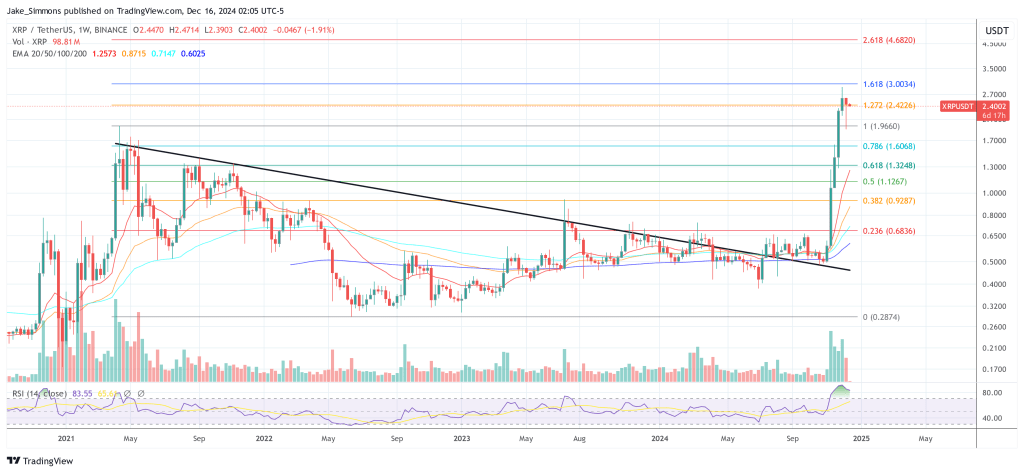Ripple CTO David “JoelKatz” Schwartz explained how RLUSD – the next stablecoin on the XRP Ledger – could initially trade at highly inflated prices, perhaps even $1,200, despite its planned peg at $1 . Speaking via
Why Ripple Stablecoin RLUSD Could Hit $1,200
In a response to community discussions around a screenshot showing an RLUSD value of $1,200 on the Xaman wallet, Schwartz confirmed that such a price is theoretically possible. He noted that “as RLUSD comes online, there could be supply shortages in the very first days before the market stabilizes. There is actually someone willing to pay $1,200/RLUSD for a tiny fraction of an RLUSD. The tools will show you the highest price anyone is willing to pay, even if it’s just for a very small amount. Maybe someone wants to have the “honor” of buying the first piece of RLUSD on the DEX.
However, he was quick to point out that “the price will return very close to $1 as soon as supply stabilizes”, suggesting that any eye-popping quote would be more of a novelty event than a true assessment of the long-term market of the RLUSD. value. “But rest assured, the price will return very close to $1 as soon as supply stabilizes. (…) If you want to spend a lot of money to get a little bit of RLUSD before everyone else, you can. But don’t expect the price to stay above $1 once things stabilize, which I hope will happen very quickly.
According to Ripple’s CTO, part of the reason for these anomalies lies in the basic minting and burning mechanisms that underpin stablecoins. Minting the Ripple stablecoin involves creating new units when demand increases, while burning involves removing units from circulation when demand decreases. Both processes help maintain the $1 exchange rate, but can lag behind real-time trading. At launch, an imbalance between the number of tokens available (supply) and those seeking to purchase them (demand) could generate extreme initial price distortions.
Schwartz’s remarks on social media echo points he made at the Emergence conference in Prague. He discussed the “weird failure scenarios” that could happen when a stablecoin first goes live, jokingly referring to the possibility that “people might spend more just to own RLUSD first.” .
One scenario he described was someone paying $3, instead of $1, simply to say they are the original holder of the stablecoin. While that still pales in comparison to $1,200, the principle remains: Such anomalies, he said, could lead some buyers to falsely believe that the Ripple stablecoin might be a speculative asset rather than a stablecoin. .
“Obviously, the price is going to go back down from $3 to $1 as soon as someone mints enough of it,” noted the Ripple CTO, adding that this is where arbitrageurs play a central role. When the price of a stablecoin floats significantly above or below its peg, traders take advantage of the mismatch, either by selling at a higher price or buying at a discount and buying back at face value. This process locks the price at its target.
Schwartz also warned: “please don’t get into a stablecoin!” This is not an opportunity to get rich.
Neil Hartner, a software engineer at Ripple, recalled that GateHub USDC was “regularly costing over $2 per GateHub USD” during its initial automated market maker (AMM) phase, particularly on weekends when the company’s own processes GateHub’s creation and burning process was offline.
There are many weird failure scenarios that you might not think about when launching a stablecoin 😂 @JoelKatz in Prague about 10 days ago. $RLUSD to the moon! 🤣
Funny stuff in this crypto space. pic.twitter.com/z71gwIJcL2– 🌸Crypto Eri 🪝Carpe Diem (@sentosumosaba) December 15, 2024
A key point to remember here is that many stablecoins rely on an external entity or protocol for minting and redemption. When these processes are not operational 24/7, or when liquidity is limited outside of business hours, prices may decouple from the $1 reference rate on exchanges or platforms. specific negotiations.
Hartner cited Circle’s USDC unpeg incident in March 2023 as another telling parallel. “Price distortions can occur if minting and burning is not available 24/7. The same thing happened when USDC deindexed over a weekend. end of March 2023, because markets panicked and Circle had limited its liquidity operations outside of business hours, Hartner wrote.
Community member Khaled Elawadi.XRP wondered how stopping minting or burning could logically distort the price of a stablecoin if fiat currency redemptions ultimately remained at $1. “Surely there should be a fixed buying and selling price on the DEX and other listed exchanges? he remarked.
In response, Hartner emphasized that pegging is not imposed by universal algorithmic price setting but by traders themselves. “You don’t cash out stablecoins on exchanges, you trade them for fiat currencies with other traders,” he explained. If more stablecoins are sold than there are buyers willing to pay $1, the price on that particular exchange may fall until market participants or liquidity providers intervene.
At press time, XRP was trading at $2.40.

Featured image from YouTube, chart from TradingView.com

